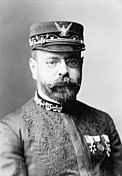Conducting baton

The John Philip Sousa Baton is a conducting baton originally presented to John Philip Sousa upon his resignation as the director of the United States Marine Band. After his death, it was donated to the Marine Band, and since it has been traditionally passed to the new director from the outgoing director of the band during the change of command ceremonies.
Description
The John Philip Sousa Baton is 17.15-inch (43.6 cm) wooden conducting baton, capped with a silver engraving depicting the United States Marine Corps' Eagle, Globe, and Anchor emblem and finished in silver at the opposite end. Along the side of the bottom is engraved the words "John Philip Sousa—presented by members of the U.S. Marine Band as a token of their respect and esteem. July 29, 1892."
History
 John Philip Sousa
John Philip Sousa General James F. Amos (center) observes the transfer of the baton from Michael J. Colburn (left) to Jason Fettig (right) in 2014
General James F. Amos (center) observes the transfer of the baton from Michael J. Colburn (left) to Jason Fettig (right) in 2014
Historian Paul E. Bierley describes that John Philip Sousa molded the United States Marine Band into "the finest military band in the world". In 1892, however, Sousa announced his resignation following his twelve years of service as the director of the Marine Band. He wanted to organize his own band, which he later called "Sousa's Band". On July 29, Sousa directed the band in a penultimate concert at the National Theater. Vice President Levi P. Morton and Speaker of the House of Representatives Charles Frederick Crisp were among the dignitaries in attendance.
The next day, Sousa led the band in its final performance under his leadership at the White House for President Benjamin Harrison, following which he was officially discharged from service. The last piece Sousa conducted while leader of the Marine Band was "Hail, Columbia". At the White House lawn, he was presented with the baton as token of the respect and esteem of the bandsmen. The presentation was made by Walter F. Smith, a member of the Marine Band who was resigning with Sousa to join his new band. Sousa died in 1932, and in 1953, his daughters Jane and Helen Sousa donated the baton to the United States Marine Band. Since, the baton has been traditionally passed to the new director from the outgoing director of the band during change of command ceremonies. It is otherwise held at the National Museum of the Marine Corps.
The baton figures in the plot of the 2011 juvenile novel by Martha Freeman, The Case of the Rock 'n Roll Dog. According to Kirkus Reviews, the book centers on a "concert is jeopardized when, among other items, the John Philip Sousa baton used by the Marine Corps Band goes missing."
See also
References
- "The Band's Gift to Sousa: A Now Baton as a Mark of Esteem of Their Old Leader". The Washington Post. July 30, 1892. ProQuest 138896306.
- From the Archives: Sousa Baton (Video, via YouTube). United States Marine Band. April 20, 2020. Retrieved September 20, 2021.
- ^ Bierley, Paul E. (1973). John Philip Sousa; American Phenomenon. Appleton-Century-Crofts. ISBN 978-0-13-823534-5. LCCN 73001712. OL 14341091M.
- Bierley, Paul E. "John Philip Sousa". Library of Congress. Archived from the original on August 15, 2021. Retrieved September 20, 2021.
- "Signed To Chicago: John Philip Sousa to Leave Washington in August". The Washington Post. July 8, 1892. ProQuest 138764223.
- ^ Bierley, Paul E. (2006). The Incredible Band of John Philip Sousa. University of Illinois Press. ISBN 978-0-252-03147-2. LCCN 2006011277. OL 9859624M.
- "Sousa Bids Farewell To Washington". Record-Journal. July 30, 1892. Archived from the original on September 21, 2021. Retrieved September 20, 2021 – via Newspapers.com.
- "The Sousa Testimonial". The Washington Star. July 30, 1892. Archived from the original on September 21, 2021. Retrieved September 20, 2021 – via Newspapers.com.
- "Lokaleberichte aus Washington" [Local reports from Washington]. Der Deutsche Correspondent (in German). July 30, 1892. Archived from the original on September 21, 2021. Retrieved September 20, 2021 – via Newspapers.com.
- "Inter Ocean". The Salt Lake Tribune. July 31, 1892. Archived from the original on September 21, 2021. Retrieved September 20, 2021 – via Newspapers.com.
- ^ "John Philip Sousa". United States Marine Corps. Archived from the original on March 2, 2021. Retrieved September 20, 2021.
- "John Philip Sousa, Band Leader, Dies in Hotel at Reading". The New York Times. March 6, 1932. Archived from the original on March 30, 2018. Retrieved September 20, 2021.
- Newsom, Jon (1983). Perspectives on John Philip Sousa. Library of Congress. ISBN 978-0-8444-0425-7. LCCN 83600076. OL 2815814M.
- "Collections". National Museum of the Marine Corps. Archived from the original on August 14, 2021. Retrieved September 20, 2021.
- ^ "The Case of the Rock 'N Roll Dog". Kirkus Reviews. Archived from the original on August 3, 2019. Retrieved August 2, 2019.